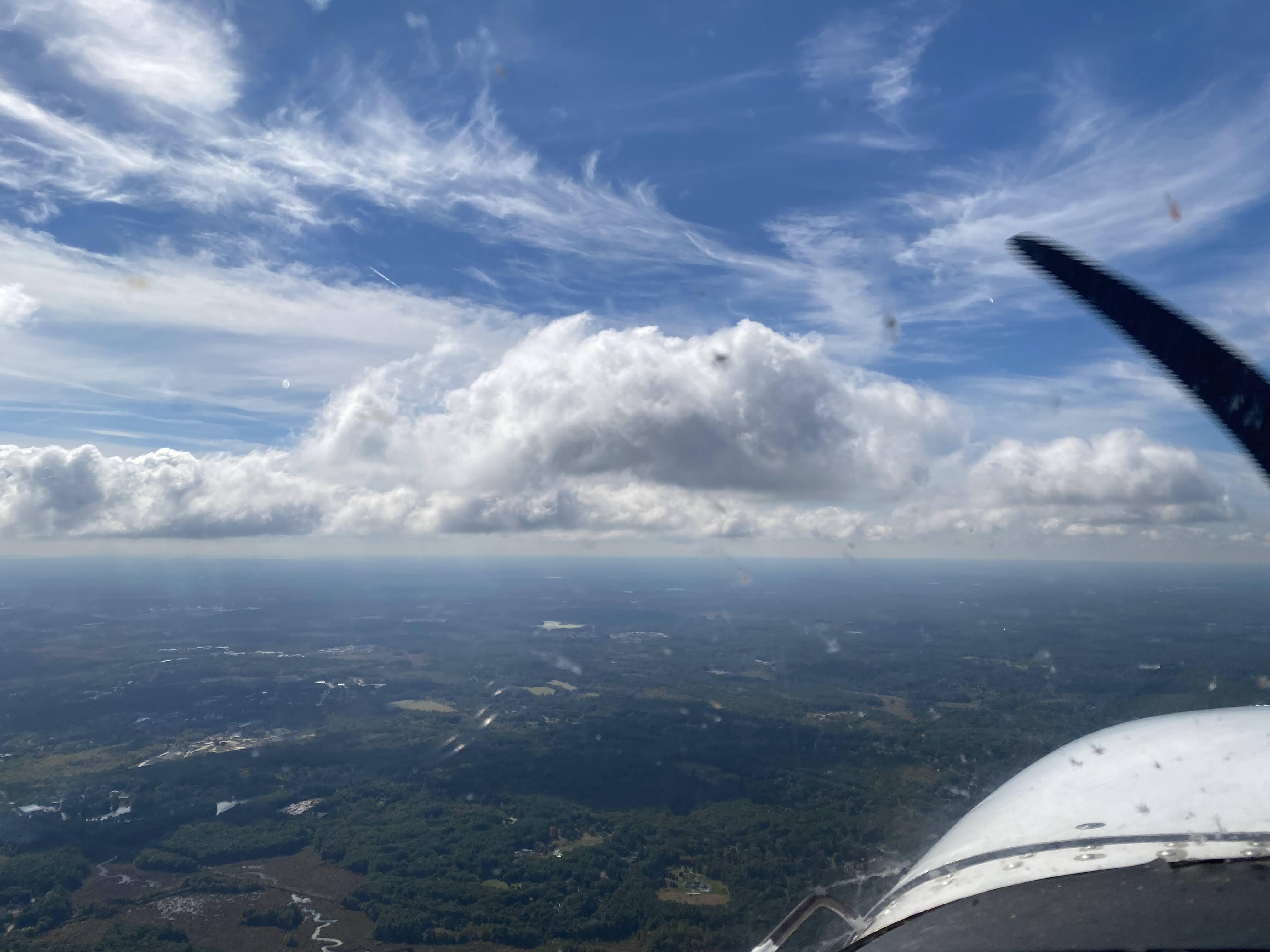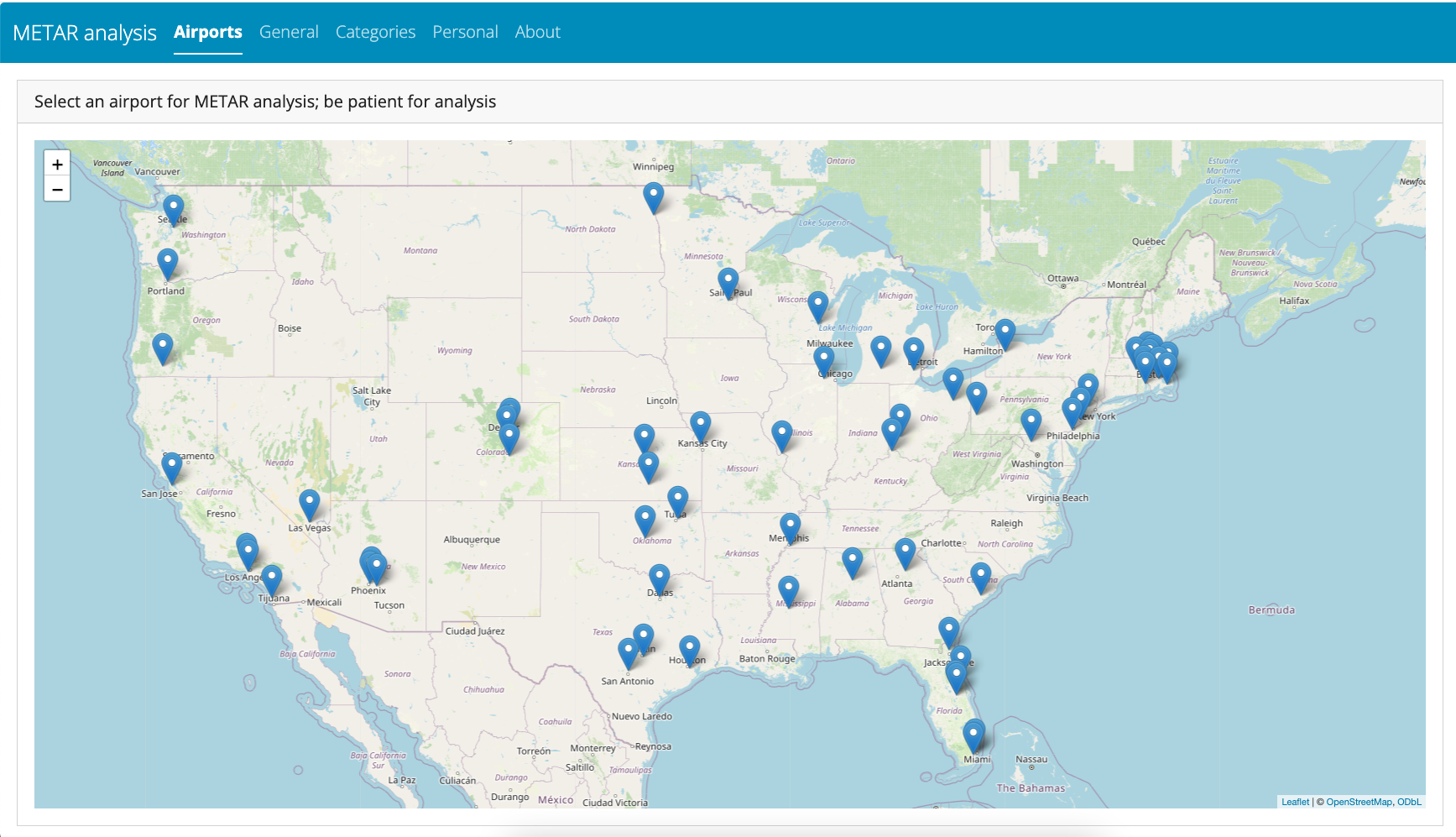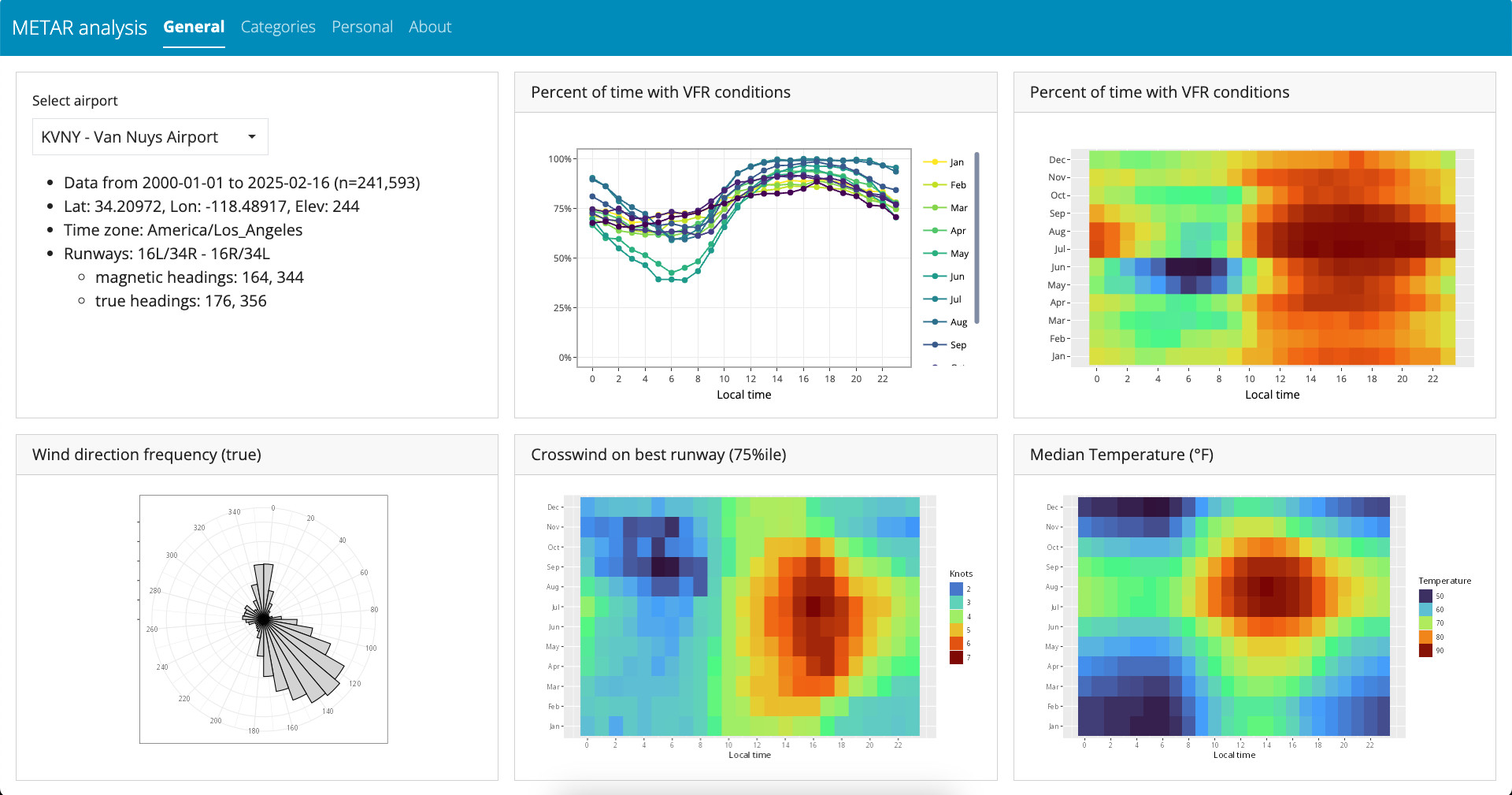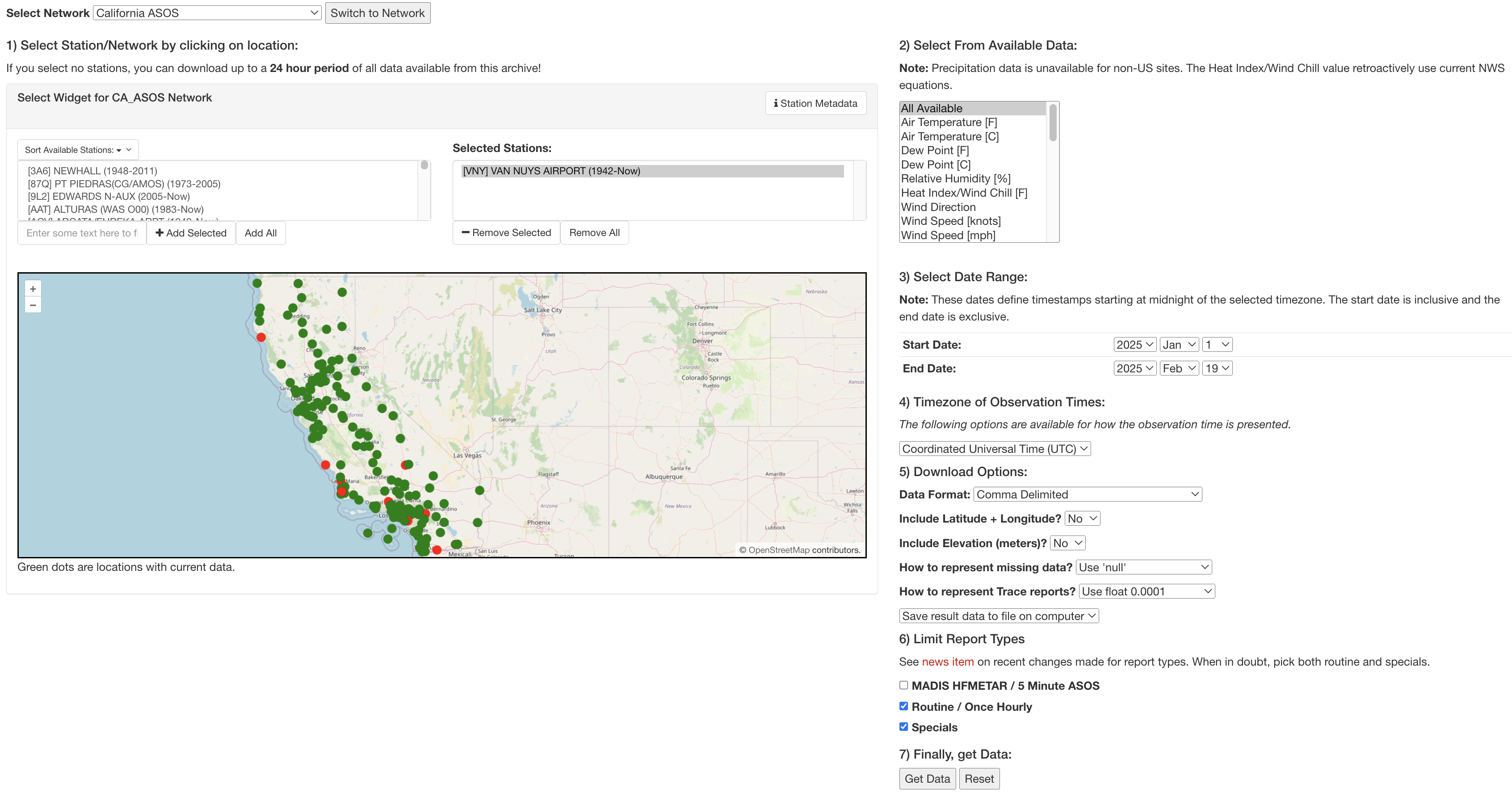library(tidyverse)
library(leaflet)
load("airports_mesonet.rda") # airports_mesonet
df <- airports_mesonet |>
filter(
online, # currently active?
between(latitude, 24.5, 49.4), # Conterminous US
between(longitude, -125, -67) # Conterminous US
) |>
select(id, name, network, latitude, longitude)
hover_labels = as.list(paste(df$id, " - ", str_to_title(df$name), " - ", df$network))
df |>
leaflet() |>
addTiles() |>
addCircleMarkers(
~longitude, ~latitude,
radius = 1,
fillOpacity = 1,
label = hover_labels
)TL;DR
Newly deployed shinylive app that runs in the client browser to allow interactive review and analysis of METAR data at a number of different airports. Access the app at https://jhchou.github.io/metar_analysis/. Comment here if you’d like any other airports added.
This won’t be an explanatory post so much as a quick list of technical improvements to the previously described analysis, of 20+ years of hourly METAR (Meteorological Aerodrome Report) weather data.
 (someplace over Walpole, MA back in September 2024)
(someplace over Walpole, MA back in September 2024)
Previous workflow:
- Airport metadata from AirNav.com
- airport name, runway headings, and time zones
- time zones ended up non-ideal; changed when accessed during daylight savings time
- Weather data from Iowa Environmental Mesonet
- data was accessed for each airport by manual web page form request
- 20 years of hourly data in CSV ASCII text typically around 70 MB of data
- Analysis within a Quarto dashboard
- generated manually, one HTML dashboard per airport
- did not use
R Shinybecause of lack of access to a Shiny server
New approach
- R
riempackage- for programmatic access to Iowa Environmental Mesonet (IEM)
- source of additional airport metadata (GPS location, stable timezone)
devbuild allows access of just the fields needed- saving more limited data as serialized R instead of CSV text decreased size of 20 years of hourlyt data from 70 MB to ~3.5 MB per airport
R shinyliveis amazingShinyallows interactive analysis, so can allow modification of personal weather minimums with immediate analysis feedback- allows serving a Shiny app as a static web page
- R/Shiny all compiled under WebAssembly to run in the client – no server needed
R leaflet- airport location metadata easily obtained from IEM metadata
shinyliveallows interactivity- use
leafletandshinyin conjunction for a nice way to select airports with available data
- Deployed to GitHub pages as a static web page
shinyliveruns client-side- smaller airport data files are reasonable to keep on GitHub
- programmatic access makes it trivial to add airports
Bottom line – really nice improvement
- from manual analysis of one airport at a time generating single airport HTML dashbaords
- to an easily deployed
Shinyapp with multiple airports available and real-time analysis
Airport selection screen

First of 3 tabs presenting results

riem package
A few details on using riem an R package to access data from the Iowa Environmental Mesonet.
My first iteration of the tool required manual selection of form inputs to select the proper ASOS network, the specific airport, and details of download options. This was already pretty tedious, so I also selected “All Available” (even though I didn’t use all the data).
When downloaded as a text CSV file, 20 years of data was ~70 MB per airport, and the manual steps were a hindrance to adding additional airports to analyze.

When I came across riem, much better programmatic solutions became possible. For a given airport, you need to know which “ASOS network” (typically a state) had the data you wanted.
The riem::riem_networks() function gives the codes for all 264 of the networks.
# Identify IA Mesonet networks
networks <- riem_networks() # 264 networks
networks |> head(n=10) |> knitr::kable()| code | name |
|---|---|
| AE__ASOS | United Arab Emirates ASOS |
| AF__ASOS | Afghanistan ASOS |
| AG__ASOS | Antigua and Barbuda ASOS |
| AI__ASOS | Anguilla ASOS |
| AK_ASOS | Alaska ASOS |
| AL__ASOS | Albania ASOS |
| AL_ASOS | Alabama ASOS |
| AM__ASOS | Armenia ASOS |
| AN__ASOS | Netherlands Antilles ASOS |
| AO__ASOS | Angola ASOS |
Likewise, the riem::riem_stations() function gives all the ASOS reporting stations available within that network.
# Identify reporting stations wihin a network
stations <- riem_stations("MA_ASOS")
names(stations)
#> [1] "index" "id" "synop" "name"
#> [5] "state" "country" "elevation" "network"
#> [9] "online" "county" "climate_site" "wfo"
#> [13] "modified" "spri" "tzname" "iemid"
#> [17] "archive_begin" "metasite" "ugc_county" "ugc_zone"
#> [21] "ncdc81" "ncei91" "longitude" "latitude"
#> [25] "wigos" "archive_end" "plot_name" "lon"
#> [29] "lat"I don’t generally like to blindly scrape websites, but it was helpful to get a list of all airports within each network. I wrote a bit of code that looped over the 264 networks and archived all the station metadata into a dataframe for future use.
To fetch the actual data, you use the riem::riem_measures() function. I initially used dev version via because the CRAN version wasn’t initially able to limit the data fields returned, but it looks like a version was released 2025-01-31 that supports it now.
The valid time for each row of weather data is reported in UTC time, but the timezone name is available in the previously obtained metadata as tzname, so it’s easy to convert to local times (needed for the use I wanted).
Simple function to fetch a from a given network’s station ID, just the fields I wanted, from a given start date, making some fields more compact by factorizing, and returning it as an R dataframe. The resulting data size when saved as a serialized R object (via saveRDS and readRDS) was much smaller, down from ~70 MB to ~3.5 MB.
get_mesonet <- function(network, id, tzname, start_date) {
riem::riem_measures(
# skyc4 and skyl4 seem to be unpopulated, but keep just in case some stations have
station = id, # station is case-sensitive, OWD worked; owd and kowd did not
date_start = start_date, # date_end not required
data = c("tmpf", "drct", "sknt", "vsby", "gust",
"skyc1", "skyc2", "skyc3", "skyc4", "skyl1", "skyl2", "skyl3", "skyl4"),
elev = FALSE, # have from metadata
latlon = FALSE, # have from metadata
report_type = c("routine", "specials")
) |>
mutate(
local = with_tz(valid, tzone = tzname), # tzname from metadata
across(c(skyc1:skyc4), as.factor)
)
}Fetching new data from an airport has become trivial thanks to riem!
For fun
Let’s plot all available stations from the archived metadata within a box enclosing the conterminous United States.

















